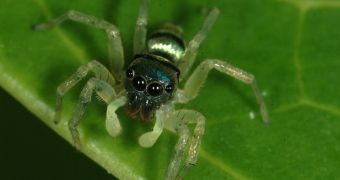Ultraviolet light is known to be harmful for most organisms if it is in excess, but some creatures are turned on by it; we could literally say they do not reach orgasm in its absence. People and mammals in general can't detect ultraviolet light, but for a bizarre type of spiders it is essential for mating, as revealed by a research published in the Current Biology journal. While most spiders are blind or almost blind, jumping spiders have an excellent vision.
However, that's not all that makes these spiders odd in comparison to other species, as they neither weave a web. UV light, for instance, just triggers in them a genuine mating frenzy. Spiders communicate with potential mates using this light that we humans cannot see.
The novelty of this new study is the finding that male jumping spiders (Phintella vittata) employ ultraviolet B (UVB) light in order to show off to females. While UVA light is known to be used by many animal species in communication, this is the first time UVB light has been found to be used for this purpose. For instance, the researchers noted that the male spiders were reflecting the ultraviolet B light off their bodies. Females were significantly more attracted by males that could communicate using UVB compared to male spiders located in chambers where UVB light was blocked with filters.
"UVA and UVB make up a small fraction of the Sun's rays, but humans cannot see them. Most previous studies have focused on UVA in animal communication, but this is the first study of UVB on any animal. Until now, scientists have assumed that animals cannot 'see' UVB, but we have found that this is not the case," said co-author Professor Daiqin Li, from the National University of Singapore.
In 2007, Li had signaled for the first time that jumping spiders use UV light in courtship behavior. "Many animals possess UV vision and use it for foraging, navigation and sexual selection," said Li.
Spiders have composed eyes and even despite the fact that receptors for UVA light have been detected, it is not yet known how they can sense UVB light.

 14 DAY TRIAL //
14 DAY TRIAL //